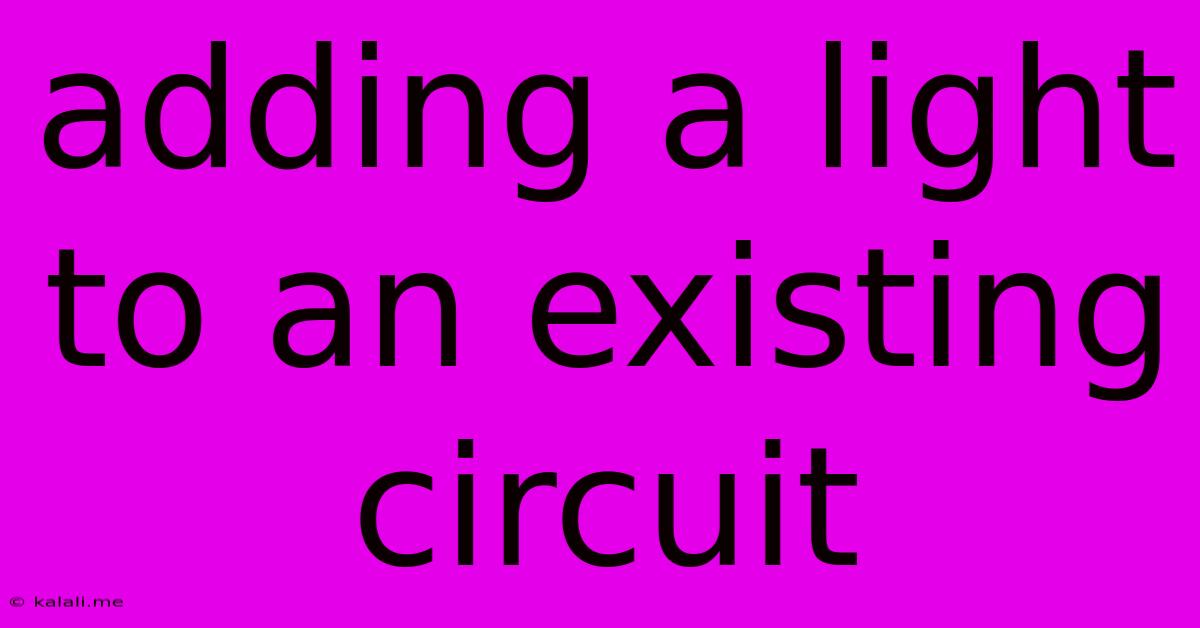Adding A Light To An Existing Circuit
Kalali
May 22, 2025 · 3 min read

Table of Contents
Adding a Light to an Existing Circuit: A Safe and Simple Guide
Adding a light fixture to an existing circuit might seem daunting, but with the right knowledge and precautions, it's a manageable DIY project. This guide provides a step-by-step walkthrough, ensuring you complete the task safely and effectively. Remember, always prioritize safety and turn off the power before beginning any electrical work. This article covers adding a light to a circuit that already has a working light fixture or outlet. Adding a completely new circuit requires different expertise and considerations.
Assessing Your Circuit and Gathering Supplies
Before you even touch a wire, assess your existing circuit. Knowing your circuit's capacity is crucial for safety. Overloading a circuit can lead to overheating and potential fire hazards. You need to determine if your existing circuit can handle the added load of a new light fixture. This often involves checking your breaker box to see the amperage of the circuit breaker protecting the circuit. Consult a qualified electrician if you're unsure.
Supplies you'll need:
- New light fixture: Choose a fixture compatible with your existing wiring and the desired aesthetic.
- Electrical box: Ensure it's rated for the new fixture's weight. You might need a new box if the existing one is inadequate.
- Wiring connectors (wire nuts): Choose connectors appropriate for the wire gauge.
- Electrical tape: For added insulation and security.
- Voltage tester: Essential for verifying power is off and checking voltage.
- Screwdrivers: Phillips and flathead, appropriately sized.
- Wire strippers: To safely remove insulation from wires.
- Fish tape (optional): If you need to run new wires through walls or ceilings.
Step-by-Step Instructions: Adding the Light
-
Turn off the power: This is the most crucial step. Locate the breaker controlling the circuit you're working on and switch it off. Use the voltage tester to confirm the power is off at the fixture location.
-
Remove the existing fixture (if applicable): Carefully detach the existing fixture, taking note of how the wires are connected. Take pictures if needed.
-
Prepare the new electrical box (if necessary): If you need a new box, install it according to the manufacturer's instructions. Make sure it's securely fastened to the structural member.
-
Connect the wires: Connect the wires from your new light fixture to the existing wires in the electrical box. Typically, you'll have a black (hot), white (neutral), and bare copper (ground) wire. Connect matching colors using wire nuts. Make sure the connections are tight and secure. Grounding is crucial for safety.
-
Mount the light fixture: Securely attach the new light fixture to the electrical box according to the manufacturer's instructions.
-
Tuck away the wires: Neatly tuck the wires into the electrical box, ensuring none are pinched or exposed.
-
Turn the power back on: Carefully switch the breaker back on. Test the new light fixture to confirm it works correctly.
-
Final Inspection: Double-check all connections for tightness and security.
Troubleshooting and Safety Precautions
- If the light doesn't work: Recheck all connections, paying close attention to the grounding wire. Ensure the breaker is switched on.
- If you encounter any problems: Don't hesitate to consult a qualified electrician. Electrical work can be dangerous; safety should always be your top priority.
- Never work with electricity if you're unsure of what you're doing: Improper electrical work can lead to injury, fire, or even death.
This guide provides a general overview. Specific wiring configurations may vary depending on your home's electrical system. Always refer to your local electrical codes and regulations. Remember, if you're not comfortable working with electricity, it's best to hire a licensed electrician. Prioritizing safety ensures a successful and hazard-free project.
Latest Posts
Latest Posts
-
Wire A 2 Gang Light Switch
May 22, 2025
-
Is There A Post Office At Heathrow Airport
May 22, 2025
-
It Is What It Is Latin
May 22, 2025
-
Why Do The Stomata Close At Night
May 22, 2025
-
How Long Does A Budgie Egg Take To Hatch
May 22, 2025
Related Post
Thank you for visiting our website which covers about Adding A Light To An Existing Circuit . We hope the information provided has been useful to you. Feel free to contact us if you have any questions or need further assistance. See you next time and don't miss to bookmark.